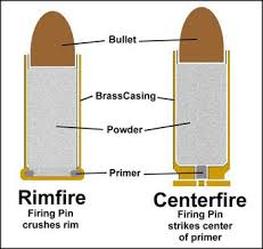Examine This Report on Remington Primers
Wiki Article
All about Winchester Primers
Table of ContentsOur Reloading Primers StatementsPrimers In Stock Fundamentals ExplainedNot known Details About Pistol Primers Reloading Primers for Beginners5 Easy Facts About Primers In Stock Explained
Component of the gun cartridge for initiating propellant combustion In weapons as well as weapons, the primer () is the chemical and/or tool in charge of launching the propellant burning that will push the projectiles out of the weapon barrel. In very early black powder weapons such as muzzleloaders, the guide was essentially the exact same chemical as the main propellant (albeit typically in a finer-powdered kind), however put right into an external flash pan, where it might be fired up by an ignition resource such as a sluggish match or a flintlock though some muzzleloaders have guides like cap gun caps. federal primers.
In artillery the guides are frequently a separate element, put inside the barrel to the back of the primary propellant chargebut there are various other instances of weapons, consisting of for example some automatic weapons, created to fire cartridges with important electric primers.
About Reloading Primers

This opening was loaded with finely ground powder, which was after that fired up with a hot cinder or lantern. With the advent of hand-held firearms, this came to be an unfavorable method of firing a weapon. Holding a burning stick while trying to put a cost of black powder carefully down a barrel is hazardous, and also attempting to hold the weapon with one hand while concurrently intending at the target and trying to find the touchhole makes it extremely tough to fire accurately. [] The initial effort to make the process of shooting a little arm simpler was the "matchlock".
The suit was a slow-burning fuse constructed from plant fibers that were saturated in an option of nitrates, charcoal, as well as sulfur, and also dried (https://www.indiegogo.com/individuals/30540624). This "slow-match" was stired up prior to the gun was needed, and it would gradually shed, keeping a hot coal at the burning end. After the gun was packed as well as the touchhole primed with powder, the burning pointer of the match was placed to make sure that the lock would certainly bring it into contact with the touchhole.
See This Report about Reloading Primers
This brought the match down to the touchhole, igniting the powder - https://events.education.ne.gov/user/relodprim3rs/. With mindful attention, the slow-burning match can be maintained melting for lengthy durations of time, and the use of the lock mechanism made fairly precise fire possible. The following change in ignition innovation was the "wheel-lock".

The protected flashpan additionally offered some capability to stand up to poor weather condition. primers for sale. Wind, rain, and also damp weather would render a matchlock ineffective, yet a wheel-lock that was packed as well as waterproofed with a little oil around the flashpan might be terminated under many problems. The wheel-lock appreciated only a short duration of appeal before being superseded by a simpler, much more durable style.
Our Winchester Primers Diaries
As the name indicates, the flintlock made use of flint rather than iron pyrite. The flint was kept in a spring-loaded arm, called the "cock" from the similarity of its activity to a pecking poultry. The dick turned through around a 90-degree arc and was held in the tensioned, or "cocked" position by a trigger. https://sco.lt/8jNkWm.The "half-cock" placement held the dick halfway back, and utilized a deep notch to make sure that shooting would certainly not release the dick. Half-cock was a security setting, made use of when packing, keeping or carrying web link a loaded flintlock. The "full-cock" placement held the cock completely back and also was the position from which the gun was fired.
It worked as both a flashpan cover and also a steel striking surface area for the flint. The frizzen was hinged as well as spring-loaded to make sure that it would certainly secure in the open or shut placement. When shut, the striking surface was positioned to ensure that the flint would strike at the proper angle to produce a stimulate.
Our Small Pistol Primers Statements
The flintlock system was simpler and also more powerful than the wheel-lock, and the flint as well as steel offered a great, trusted resource of ignition. The flintlock remained in armed forces solution for over 200 years, as well as flintlocks are still made today for historic re-enactments and also muzzle-loading target competition, as well as for hunters that delight in the extra difficulty that the flintlock provides.Percussion ignition was created by Scottish clergyman Rev. Alexander John Forsyth in 1807 but needed even more refinements before it was progressively approved in the 1820s to 1830s. By the middle of the 19th century, the percussion or caplock system was well developed. It was adopted by both sides in the American Civil Battle, as it was easier as well as much more trustworthy than the flintlock.
The flashpan as well as frizzen were gotten rid of and also changed by a small, hollow horizontal cylinder (drum) screwed into the bored-out as well as touched flash opening and also lugging a "nipple area" over which the cap could be fitted. A "hammer" which additionally had half-cock (for packing and using the cap) and also full-cock placements replaced the dick.
Report this wiki page